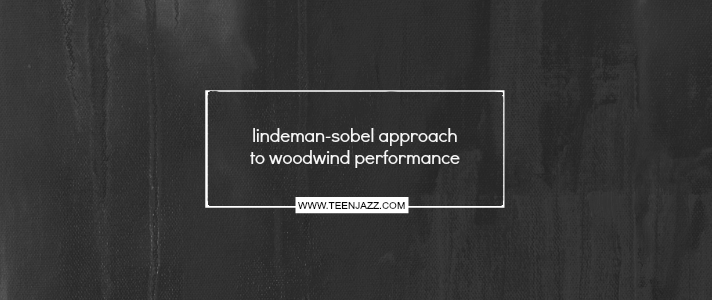Part I
My name is Leo Potts and I’d like to share with you some concepts of the Lindeman-Sobel Approach to Artistic Wind Performance.
The first concept we’ll deal with is “how do you play the first note of a musical phrase?”
Now prior to playing the first note of a musical phrase, most musicians will already have the keys depressed. Let’s say it’s “b”. If I already have the key down… Now the sound is going to be produced at the mouth, at the mouthpiece, so the reed is not going to vibrate the way that it should and the sound is going to be tight. It’s going to sound like this. [demonstrates]
The concept that I’m dealing with is that I never have my fingers down before I play. It’s all about airstream, articulating with the tongue, and fingers meeting at the same time, creating that first note.
You know what, we can use this analogy, it’s kind of interesting. If I’m playing baseball, let’s say. The idea is that I have my bat and the pitcher throws the ball and I swing, and the bat and the ball meet to create that home run. That energy. That’s what happens when I don’t have the finger down. It’s right there.
Now the other way, if I already have my finger down, it’s more to me like it’s like I stick the bat out there [places hands together in front of body] the pitcher throws [the ball] and I hope, that maybe, he might hit the bat.
This is my concept of producing the perfect note. I’m not going to have a finger down before I play, so I’m feeling the pearl on my finger. Ready to put that finger down. Feeling that energy. Now I’m going to breathe from the diaphragm. In one continuous motion, the articulation, air meeting the finger as it closes. No [pause], [the air is] through into [the finger].
Here we go. [demonstrates]
Now just say I’m going to start the note without the tongue at all so that it’s going to be quite. It’s going to be sort of like it’s sneaking in but you’re going to hear the beginning of the note. It’s just not percussive in any way, shape, or form. [demonstrates]
I’d like to, one more time, just let you hear what it sounds like when the key is down as far as sound is concerned, articulation, and the beginning of the note. And then when I’m doing the concept of air and fingers meeting to create that sound. So he we are [with the finger down] and it’s more a matter of thinking up here [points to mouthpiece] than here [points to hand].[demonstrates both]
It’s a much richer sound. The fundamental of the sound is there and it doesn’t sound tight. It’s open and singing. And that’s really what I’m trying to do all the time. Air and fingers meet to create that.
So that’s a concept that I’m dealing with. Try it. Work on it and see how you like it. And enjoy.
For more information, visit leopotts.com
Part II
My name is Leo Potts and I’d like to share with you some concepts of the Lindeman-Sobel Approach to Artistic Wind Performance.
This is session two, a continuation of session one. I would like to introduce you to the concept of finger technique. The tendency is to slap a key down and upon the release, let the finger fly. This is going to affect the quality of sound and pitch relationship. Let me just demonstrate that really quickly for you. I’m going to put [my fingers] down not very nicely and release them the same way. [demonstrates]
As you can hear, the tone quality on the release, the pitch relationship is sharp and I’ve lost all the bottom int he sound. Now I’m going to do it conceptually the way that I think. [demonstrates]
Now I’ve a balance of tone quality. Nothing is sticking out, nothing is popping out. The upper note is not exploding on me. Something I find very helpful is to practice in front of a mirror. This way, you can see your fingers. You can see if you’re really keeping your fingers on the pearls. And now you’ll be able to hear the difference. Your tone quality will be the same. The line will flow and actually, it will be easier to play.
So the next time I’ll be in your area, I hope you’ll come and join me for my master clinic and hope to see you then. Thank you.
[template id=”182″]
